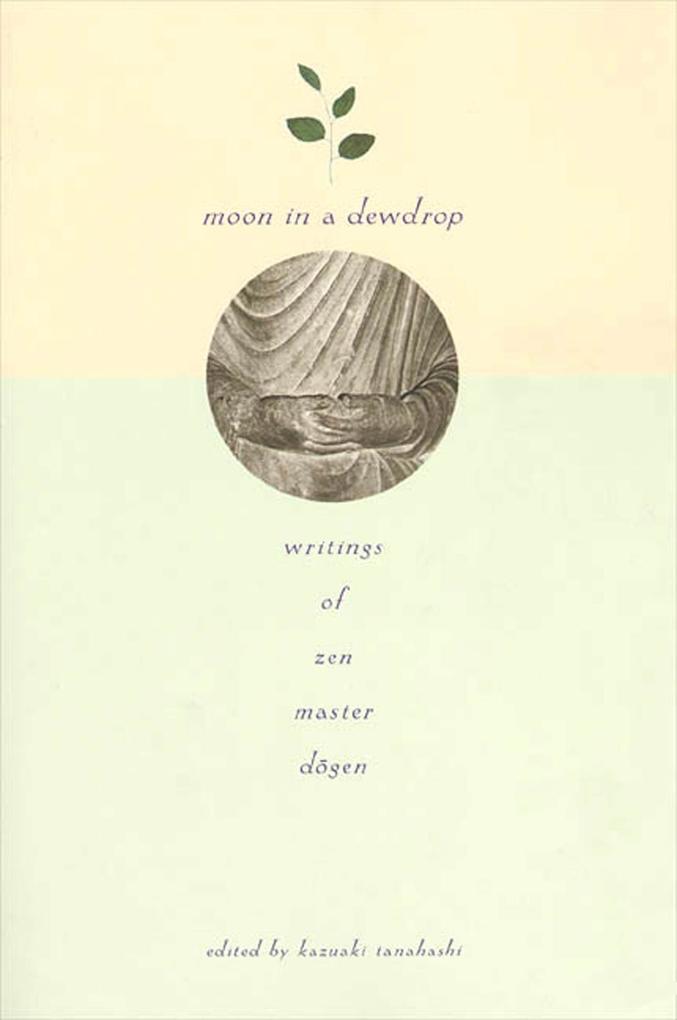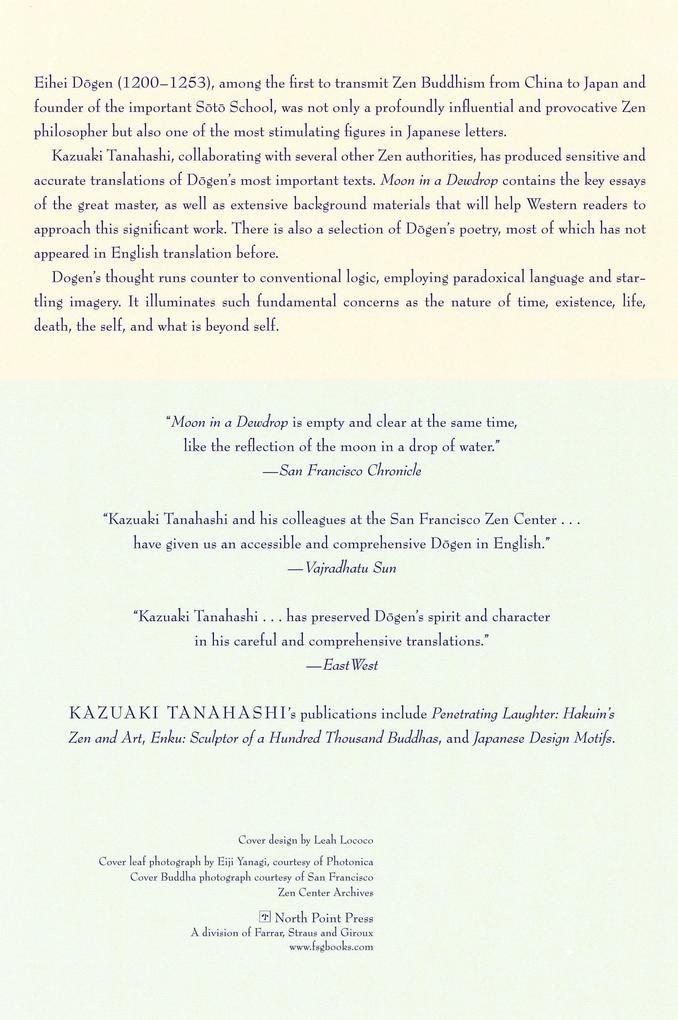
Zustellung: Do, 17.07. - Di, 22.07.
Versand in 2 Wochen
VersandkostenfreiEihei Dogen (1200-1253), among the first to transmit Zen Buddhism from China to Japan and founder of the important Soto School, was not only a profoundly influential and provocative Zen philosopher but also one of the most stimulating figures in Japanese letters.
Kazuaki Tanahashi, collaborating with several other Zen authorities, has produced sensitive and accurate translations of Dogen's most important texts. Moon in a Dewdrop contains the key essays of the great master, as well as extensive background materials that will help Western readers to approach this significant work. There is also a selection of Dogen's poetry, most of which has not appeared in English translation before.
Dogen's thought runs counter to conventional logic, employing paradoxical language and startling imagery. It illuminates such fundamental concerns as the nature of time, existence, life, death, the self, and what is beyond self.
Kazuaki Tanahashi, collaborating with several other Zen authorities, has produced sensitive and accurate translations of Dogen's most important texts. Moon in a Dewdrop contains the key essays of the great master, as well as extensive background materials that will help Western readers to approach this significant work. There is also a selection of Dogen's poetry, most of which has not appeared in English translation before.
Dogen's thought runs counter to conventional logic, employing paradoxical language and startling imagery. It illuminates such fundamental concerns as the nature of time, existence, life, death, the self, and what is beyond self.
Inhaltsverzeichnis
Preface and Acknowledgements
Abbreviations, Transliteration, Systems of Counting, and Capitalization
Introduction: The Life of Zen Master Dogen and Dogen's Teaching
PART ONE: PRACTICAL INSTRUCTIONS
Rules for Zazen (Zazen-gi)
Guidelines for Studying the Way (Gakudo Yojin-shu)
Bodhisattva's Four Methods of Guideance (Bodaisatta Shisho-ho)
Regulations for the Auxiliary Cloud Hall (Juundo-shiki)
Instructions for the Tenzo (Tenzo Kyokun)
PART TWO: PHILOSOPHICAL WORKS
Actualizing the Fundamental Point (Genjo Koan)
Birth and Death (Shoji)
The Time-Being (Uji)
Undivided Activity (Zenki)
Body-and-Mind Study of the Way (Shinjin Gakudo)
PART THREE: POETIC IMAGERY
Mountains and WAters Sutra (Sansui-kyo)
Spring and Autumn (Shunju)
Plum Blossoms (Baika)
Everyday Activity (Kajo)
The Moon (Tsuki)
Painting of a Rice-cake (Gabyo)
PART FOUR: TRANSMISSION OF TEACHING
On the Endeavor of the Way (Bendo-wa)
Only Buddha and Buddha (Yuibutsu Yobutsu)
Twining Vines (Katto)
Face-to-Face Transmission (Menju)
Buddha Ancestors (Busso)
Document of Heritage (Shisho)
All-Inclusive Study (Henzan)
Going beyond Buddha (Bukkojoji)
PART FIVE: POEMS
Waka Poems
Chinese-style Poems
APPENDIXES
Appendix A: "Reading the Record of Eihei Dogen" by Ryokan
Appendix B: Chinese Transliteration: Comparative Table
Appendix C: Maps
Appendix D: Lineage Charts of Chinese Zen Masters
Notes
Selected Bibliography
Glossary and Index
Abbreviations, Transliteration, Systems of Counting, and Capitalization
Introduction: The Life of Zen Master Dogen and Dogen's Teaching
PART ONE: PRACTICAL INSTRUCTIONS
Rules for Zazen (Zazen-gi)
Guidelines for Studying the Way (Gakudo Yojin-shu)
Bodhisattva's Four Methods of Guideance (Bodaisatta Shisho-ho)
Regulations for the Auxiliary Cloud Hall (Juundo-shiki)
Instructions for the Tenzo (Tenzo Kyokun)
PART TWO: PHILOSOPHICAL WORKS
Actualizing the Fundamental Point (Genjo Koan)
Birth and Death (Shoji)
The Time-Being (Uji)
Undivided Activity (Zenki)
Body-and-Mind Study of the Way (Shinjin Gakudo)
PART THREE: POETIC IMAGERY
Mountains and WAters Sutra (Sansui-kyo)
Spring and Autumn (Shunju)
Plum Blossoms (Baika)
Everyday Activity (Kajo)
The Moon (Tsuki)
Painting of a Rice-cake (Gabyo)
PART FOUR: TRANSMISSION OF TEACHING
On the Endeavor of the Way (Bendo-wa)
Only Buddha and Buddha (Yuibutsu Yobutsu)
Twining Vines (Katto)
Face-to-Face Transmission (Menju)
Buddha Ancestors (Busso)
Document of Heritage (Shisho)
All-Inclusive Study (Henzan)
Going beyond Buddha (Bukkojoji)
PART FIVE: POEMS
Waka Poems
Chinese-style Poems
APPENDIXES
Appendix A: "Reading the Record of Eihei Dogen" by Ryokan
Appendix B: Chinese Transliteration: Comparative Table
Appendix C: Maps
Appendix D: Lineage Charts of Chinese Zen Masters
Notes
Selected Bibliography
Glossary and Index
Produktdetails
Erscheinungsdatum
31. Oktober 1995
Sprache
englisch
Seitenanzahl
368
Autor/Autorin
Eihei Dogen
Herausgegeben von
Kazuaki Tanahashi
Übersetzung
Robert Aitken, Reb Anderson, Ed Brown, Norman Fischer, Arnold Kotler, Daniel Leighton, Lew Richmond, David Schneider, Kazuaki Tanahashi, Katherine Thanas, Brian Unger, Mel Weitsman, Dan Welch, Philip Whalen
Verlag/Hersteller
Produktart
kartoniert
Gewicht
540 g
Größe (L/B/H)
235/156/25 mm
ISBN
9780865471863
Pressestimmen
""Moon in a Dewdrop" is empty and clear at the same time, like the reflection of the moon in a drop of water."--"San Francisco Chronicle"
"Kazuaki Tanahashi and his colleagues at the San Francisco Zen Center...have given us an accessible and comprehensive Dogen in English."--"Vajradhatu Sun"
"Kazuaki Tanahashi...has preserved Dogen's spirit and character in his careful and comprehensive translations."--"East West"
"Kazuaki Tanahashi and his colleagues at the San Francisco Zen Center...have given us an accessible and comprehensive Dogen in English."--"Vajradhatu Sun"
"Kazuaki Tanahashi...has preserved Dogen's spirit and character in his careful and comprehensive translations."--"East West"
Bewertungen
0 Bewertungen
Es wurden noch keine Bewertungen abgegeben. Schreiben Sie die erste Bewertung zu "Moon in a Dewdrop" und helfen Sie damit anderen bei der Kaufentscheidung.








